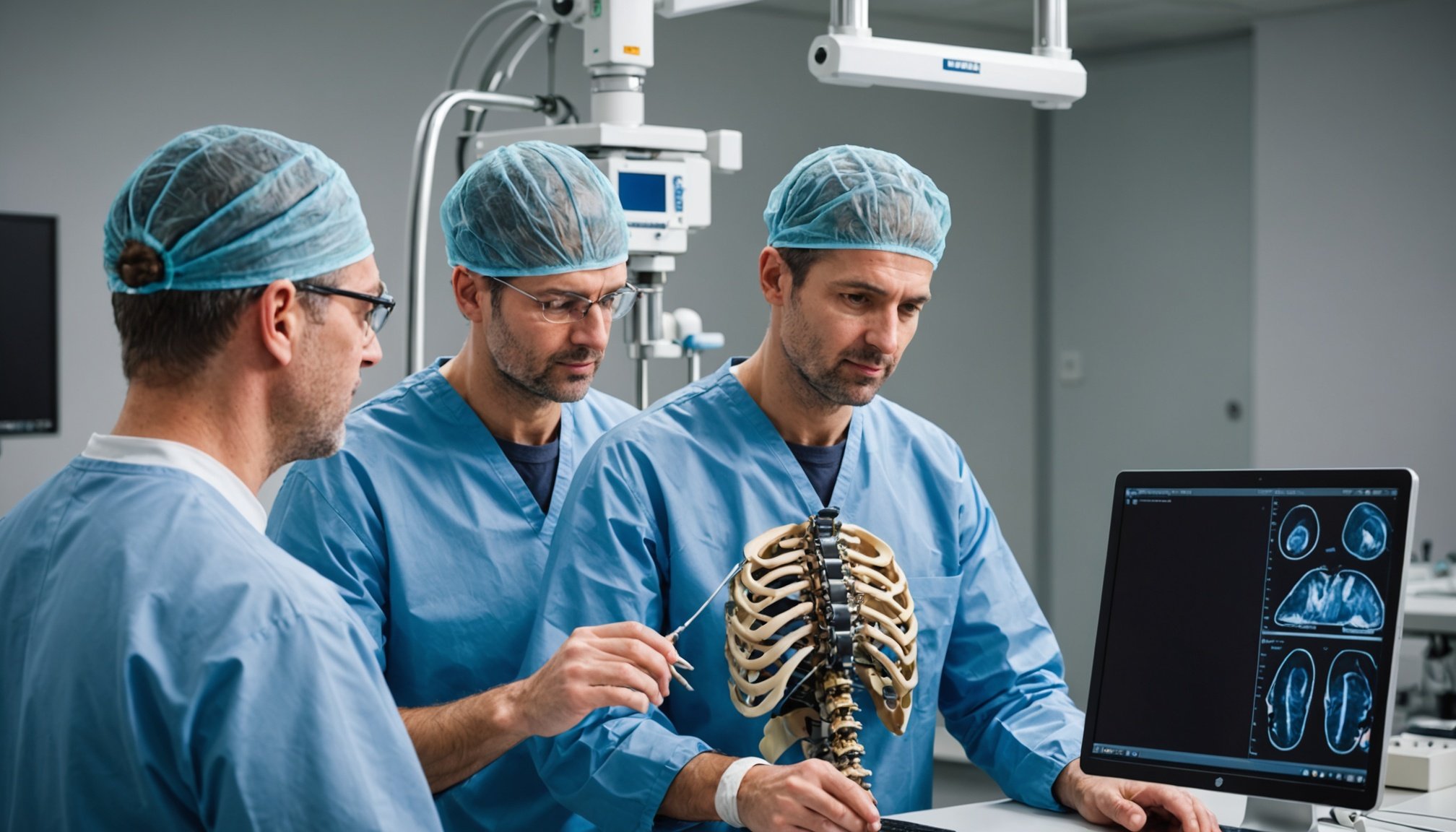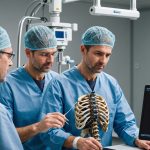Overview of Minimally Invasive Spine Surgery Techniques
Minimally invasive spine surgery (MISS) involves advanced techniques designed to reduce the physical trauma associated with traditional open surgery. Unlike its open counterpart, MISS utilises smaller incisions, often leading to less damage to surrounding tissue, and quicker recovery. Core principles include precision targeting of the affected area and maintaining maximum muscle and tissue integrity.
In the UK, many orthopedic surgeons are rapidly adopting these methods, attracted by their reduced complication rates and the potential for improved patient satisfaction. As healthcare systems increasingly emphasise efficiency and patient comfort, minimally invasive techniques are rising in popularity.
Also to discover : Effective Non-Medication Strategies for UK Pediatricians in ADHD Management: Best Practices Unveiled
A comparison reveals that MISS often results in less postoperative pain, lower risk of infection, and shorter hospital stays. Such advantages make it a compelling option for patients and surgeons alike. Given these benefits, the shift towards minimally invasive options is expected to continue, ensuring wider accessibility and consistency in successful surgical outcomes as surgeons refine and expand their skillsets. Understanding the nuances between traditional and minimally invasive approaches empowers patients to make informed decisions about their healthcare options.
Innovative Techniques Employed by UK Orthopedic Surgeons
In the evolving field of spine surgery, UK orthopedic surgeons are at the forefront, utilising advanced surgical techniques such as spinal decompression and fusion to enhance patient care. These methods integrate cutting-edge technology to ensure precise and effective outcomes.
Also to discover : Exploring the Cutting-Edge Innovations in Robotic Surgery for Gynecological Procedures: A Guide for UK Surgeons
Robotic-Assisted Surgery
Robotic-assisted surgery is revolutionising how spinal procedures are conducted. By leveraging robotics, surgeons achieve greater accuracy in executing complex surgeries with minimal disruption to surrounding tissues. Patients benefit from this approach through reduced recovery times and improved surgical success rates, leading to enhanced patient satisfaction.
Endoscopic Spine Surgery
The use of endoscopic spine surgery allows for minimally invasive access to the spinal column. By employing small incisions and specialised instruments, this technique minimises postoperative discomfort and accelerates healing. Technological progress has made this method more prevalent, with favorable outcomes becoming the norm.
Tubular Retractor Techniques
Tubular retractors present another innovation, functioning to gently separate muscles and provide clear visibility during surgery. This approach reduces muscle damage and speeds up recovery, which translates into a significant advantage for patients interested in maintaining their current lifestyle without prolonged disruptions.
These advanced techniques pioneered by UK surgeons are not only demonstrating marked improvements in patient care but also setting the stage for future advancements in minimally invasive spine surgery.
Innovative Techniques Employed by UK Orthopedic Surgeons
Innovative methods in minimally invasive spine surgery exemplify the pinnacle of advanced surgical techniques being embraced by UK orthopedic surgeons. These contemporary modalities include robotic-assisted surgery, endoscopic spine surgery, and tubular retractor techniques, each presenting unique benefits for patient care.
Robotic-Assisted Surgery
In robotic-assisted surgery, surgeons utilise robotic arms to enhance surgical precision, allowing for meticulous spinal decompression and fusion procedures. This precision often results in smaller incisions, reduced trauma, and shorter recovery times, improving patient experience.
Endoscopic Spine Surgery
Endoscopic spine surgery utilises small incisions and an endoscope to address spinal issues. The technique provides real-time visuals, ensuring better navigation during surgery. This method diminishes recovery time and hospital stay, heightening patient comfort.
Tubular Retractor Techniques
Tubular retractor techniques maintain muscle tension through a dilator system, facilitating access to the spine with minimal tissue disruption. Patients benefit from fewer complications and swift recovery, thanks to the reduced impact on surrounding tissues.
Driven by advancements in technology, these techniques significantly impact patient outcomes by minimising operational risks. This surge in technological sophistication ensures UK orthopedic surgeons are delivering surgery benefits with enhanced efficacy and patient satisfaction.
Technological Advancements in Spine Surgery
The realm of spine surgery is witnessing significant transformations due to the infusion of surgical technology. Emerging innovations like imaging and navigation systems are revolutionising traditional methodologies by enhancing surgical precision. These advancements are proving indispensable for orthopedic surgeons who aim for more accurate outcomes in minimally invasive procedures.
High-resolution imaging allows for detailed preoperative mapping and intraoperative guidance. This precision minimises risks associated with misalignment or excessive tissue handling, which is crucial for successful minimally invasive surgeries. Moreover, digital tools like 3D modelling facilitate comprehensive planning, enabling surgeons to anticipate challenges and strategise interventions effectively.
Future trends in orthopedic surgical technology are poised to reshape the landscape further. Innovations like augmented reality and artificial intelligence are on the horizon, promising to provide even more precise navigation and real-time feedback. The integration of these cutting-edge technologies is not only enhancing current practices but also establishing new benchmarks for surgical excellence.
As the pursuit of innovation continues, the adoption of advanced surgical technologies will play an ever-increasing role in improving patient outcomes, minimising recovery times, and ensuring safer, more effective patient care.
Benefits of Advanced Minimally Invasive Techniques
Advanced minimally invasive techniques offer significant advantages in comparison to traditional surgical methods. One of the primary benefits is the notably shorter recovery times, allowing patients to return to their daily lives more quickly. This expedited healing is largely due to the reduced physical trauma from smaller incisions and less tissue disruption. For many, this means less time spent in a hospital and a faster resumption of normal activities.
Moreover, these techniques contribute to decreased operational risks and complications. With precision-driven technology and refined methodologies, there is a lower likelihood of infections and postoperative issues. This reduction in complications provides both patients and surgeons with greater peace of mind.
Enhanced patient comfort is another substantial benefit. Minimized incisions not only mean less postoperative pain but also reflect favorably on the cosmetic outcomes as scarring is minimized. Consequently, patient satisfaction tends to be notably higher with these advanced approaches.
Ultimately, the blend of cutting-edge technology and refined surgical strategies ensures that patients receive safer, more effective care with outcome-focused results. This trend is positively changing the landscape of spinal surgery, further strengthening the push toward minimally invasive procedures.
Patient Outcomes and Case Studies
Utilising minimally invasive spine surgery techniques has yielded significant improvements in patient outcomes. Through various case studies, it’s evident these procedures lead to faster recovery and lower complication rates compared to traditional surgery. This success is attributed to the precision and reduced trauma inherent in such procedures.
Case Study Analysis
A comprehensive analysis of case studies reveals a pattern of surgical success in patients who underwent minimally invasive spinal procedures. Notably, patients experienced quicker return to daily activities and reported less postoperative pain, affirming the effectiveness of these advanced methods.
Patient Testimonials
Testimonials from patients also underscore the benefits of minimally invasive techniques. Many express high satisfaction with reduced recovery times and diminished postoperative discomfort. Real accounts provide authenticity and deepen trust in these cutting-edge procedures.
Long-Term Outcomes
Reviewing long-term data, patients who opt for minimally invasive surgery often experience sustained results with minimal recurrence of symptoms. Statistics support a trend of lasting improvements in quality of life and functionality, demonstrating the superiority of these methods over conventional surgeries. Incorporating factual data and testimonials strengthens the understanding of their positive impact on surgical success rates.
Patient Outcomes and Case Studies
In minimally invasive spine surgery, an array of patient outcomes and case studies underline the efficacy of these advanced techniques. This builds a persuasive narrative around the surgical success associated with these procedures.
Case Study Analysis
Analysing case studies provides substantive evidence of successful surgeries. For instance, numerous UK orthopedic surgeons have reported cases where patients experienced significant postoperative improvements. These studies often detail reduced recovery times and improved mobility post-surgery, demonstrating the effectiveness of minimally invasive techniques in real-world scenarios.
Patient Testimonials
Patient testimonials offer credibility to the success of these procedures. Many patients describe experiencing less pain and shorter hospital stays, echoing the benefits highlighted in clinical trials. These first-hand accounts not only add a personal dimension to surgical statistics but also serve as reassurance to potential patients considering their surgical options.
Long-Term Outcomes
Statistics on long-term patient outcomes further strengthen the appeal of minimally invasive techniques. According to recent studies, patients undergoing these procedures consistently show better long-term recovery compared to traditional surgeries. These findings highlight the substantial advantages in both immediate and lasting patient outcomes, offering a compelling reason for the continued adoption and refinement of minimally invasive spine surgery techniques.
Considerations, Risks, and Accessibility
Understanding the intricacies of minimally invasive surgery involves examining potential risks, accessibility, and comparison with traditional methods. While these advanced techniques offer numerous benefits such as quicker recovery and reduced complications, they are not devoid of risks. Potential complications include nerve damage, infection, and procedural errors, albeit at a lower incidence compared to conventional surgeries. The precision required in these procedures demands high expertise and meticulous attention from surgeons.
Potential Risks and Complications
Although minimally invasive spine surgery typically results in favourable outcomes, complications like incomplete decompression or hardware misplacement can occur. Precision-driven planning and execution help mitigate these risks. Nonetheless, comprehensive preoperative assessments remain crucial in minimising surgical risks.
Accessibility of Minimally Invasive Surgery in the UK
Patient accessibility to these techniques varies by region, with urban areas generally offering more options than rural ones. Advances in technology and increased integration into healthcare systems aim to improve availability across the UK.
Comparison with Traditional Surgical Access
Traditional surgery, often more accessible, involves longer recovery and higher complication rates. Conversely, minimally invasive operations feature restricted access but promise expedited healing and enhanced patient experience, pushing for broader implementation within the healthcare landscape.
Expert Opinions and Insights
Orthopedic specialists play a crucial role in shaping the future of minimally invasive spine surgery. Their deep understanding of surgical expertise informs advancements in techniques, which promise fewer complications and improved patient outcomes. Through interviews, these surgeons emphasise the continuous evolution of their field, with many acknowledging the transformative impact of surgical technology.
Leading UK orthopedic specialists stress the importance of ongoing professional development to stay abreast of new methodologies and tools. Training initiatives, such as workshops and seminars, are integral in equipping surgeons with the requisite skills for complex procedures. These educational opportunities foster a culture of innovation and excellence within the surgical community.
Furthermore, experts predict a growing shift towards patient-centric approaches, ensuring that surgical interventions are both effective and minimally invasive. This evolution reflects the need for advanced techniques that cater to modern patient expectations and healthcare standards. Thus, expert analysis becomes indispensable, guiding the strategic implementation of cutting-edge technologies. By blending expertise with emerging surgical innovations, orthopedic surgeons can continue to enhance patient care and achieve greater surgical success.
Expert Opinions and Insights
In the realm of minimally invasive spine surgery, orthopedic specialists are pivotal in driving the advancement of techniques that promise enhanced patient outcomes. During interviews, leading surgeons highlight the significance of evolving surgical expertise and the integration of progressive methods to minimise complications.
Training and Professional Development
Continuous professional development is underscored as crucial in keeping abreast of advanced surgical techniques and the latest technological innovations. Surgeons participate in workshops and seminars to hone their skills, ensuring they remain at the forefront of the field.
Future Directions in Spine Surgery
Prominent specialists foresee a shift towards patient-centric approaches, where procedures are designed to be less invasive, aligning with patient expectations for faster recovery and reduced discomfort. This ongoing evolution reflects the need for surgical techniques that incorporate patient needs and healthcare standards.
Impact of Technology and Expertise
Expert analysis reveals that technological advancements play an indispensable role in refining surgical expertise. Tools like robotic systems and imaging technology enhance precision in complex surgeries, paving the way for safer, more effective patient care. By merging expert knowledge with technological progress, the future of spinal surgery promises improved outcomes and satisfaction.
Considerations, Risks, and Accessibility
Understanding the intricacies of minimally invasive surgery involves weighing potential risks and accessibility, and comparing these to traditional methods. While these advanced techniques offer numerous benefits, including quicker recovery and reduced complications, they aren’t devoid of risks. Potential complications can include nerve damage, infection, and procedural errors, albeit at a lower incidence compared to conventional surgeries. The precision required in these procedures demands high expertise and meticulous attention from surgeons.
Potential Risks and Complications
Although minimally invasive spine surgery typically bears favorable outcomes, complications like incomplete decompression or hardware misplacement can occur. Precision-driven planning and execution help mitigate these risks. Comprehensive preoperative assessments remain crucial in minimising surgical risks.
Accessibility of Minimally Invasive Surgery in the UK
Patient accessibility to these techniques varies by region, with urban areas generally offering more options than rural ones. Advances in technology and increased integration into healthcare systems aim to improve availability across the UK.
Comparison with Traditional Surgical Access
Traditional surgery, often more accessible, may involve longer recovery and higher complication rates. Conversely, minimally invasive operations feature restricted access but promise expedited healing and enhanced patient experience, pushing for broader implementation within the healthcare landscape.











